- In Japanese society it is not unusual for a young girl to be given piano or ballet lessons, but very few continue until they reach the age of 20 or so.
- Yes. I really liked ballet, so I continued it until just before I left for Britain to study at the Laban Centre during my third year of college. I guess I just didn’t know anything else (laughs).
- After studying only ballet for so long and then going to the Laban Centre where everyone is in training wear and moving freely, didn’t you feel an aversion to it at first?
- If I had started contemporary dance in Japan I might have, but when I went to London, suddenly the whole environment was different. Everything was new and the dance was just one more new thing, so it felt natural. And it wasn’t only dance I was doing. I was going on my own to see contemporary art and listen to music and see plays. It was all one big culture shock and completely fascinating to me. The Laban Centre was just more part of the culture shock. I also went to small theaters like The Place Theatre. In Japan I had only gone to the large theaters where ballet was performed. London really changed everything for me (laughs).
- What kinds of lessons did you take at the Laban Centre?
- I did the Release technique, Graham technique, Horton and Jose Limon technique. There were also seminars by choreographers active in London at the time, and I took part in workshops by people like Matthew Bourne.
- After returning to Japan, how was it that you became a member of the Kim Itoh + the Glorious Future (Kagayaku Mirai) company?
- When I came back to Japan in the summer of my fourth year of college, I knew that I wanted to do something other than ballet, but I had to work hard on my graduation project. After that was finished and I had some free time I started thinking about what to do next and began looking around. I was going to workshops by people like Kuniko Kisanuki, Kazuyuki Futami and Kota Yamazaki and taking lessons from foreign dancers being given at the studios like The Session House. It was at that time that I went to see the Japan-Korea dance collaboration and there happened to be leaflets there for a Kim Itoh ’s workshop. I had never seen one of Kim’s performances, but I decided to go to the workshop.
- Kim Itoh comes from a Butoh background. Did you know anything about Butoh at the time?
- No, I didn’t. In a course at Tamagawa University I had learned that people like Kazuo Ono or Sankaijuku existed, but I thought they were part of the traditional dance genre (laughs). So when I went to Kim’s workshop, I asked myself, “Is this dance?” But I am the kind who has to do it all once I get started. And I think of myself as one who is pretty well coordinated and can do most of what I set out to do. So I was able to do most of the workshop menu. But, there was this “dolphin jump” movement where you lie on your stomach and make your body lift off the floor by creating a wave motion through the whole body. But I just couldn’t do it, and it really got to me! So, I was determined to take the next workshop and go to the showings. The first time I actually danced in one of Kim’s productions was in 1999, in on the map . It was early 2000 that I became a full-fledged member of the company.
- So, at the time you were dancing with the Tani Momoko ballet company and Kim’s productions at the same time. It seems that these two are completely different. How were you able to balance these two within yourself?
-
It was really fun dancing in Kim’s productions, and that was an important experience for me, but at the same time I felt intuitively that this alone was not enough.
Having the ballet lessons in the morning to humble me and then having Kim’s dances to undo my body … going back and forth between these two was just right for me. Giving up ballet would have been easy. But throwing out what this body had become accustomed to through ballet and limiting myself just to this new [Kim’s] dance didn’t seem honest to me.
Also, although there are more differences than similarities between ballet and what I have been doing with Kim or BATIK in terms of the way the body is used and the way of thinking, I think there is one aspect that they have in common. I like corps de ballet more than charactere, and when we are going through like the third act of Swan Lake I get so worked up and excited even doing the corps that I can’t stay in line. In fact, there is not really any place for that kind of personal emotion in corps de ballet. Ms. Tani would probably get mad if she heard me saying this, though (laughs). But that emotion is not necessary. In other words, it is a denial of the self that is demanded. In my works, also, I push the dancers’ bodies to the point of fatigue where they can no longer say, “I am such-and-such kind of person.” You must transcend the self. This is the aspect that ballet and my other dance have in common. - How did SIDE-B come to be choreographed just for women?
-
I created this piece in 2001, about two years after coming back from the Laban Centre, when I was 22 or 23.
Kim was overseas, so there was free time at the company. It was when I had this free time that suddenly the idea for SIDE-B came to me. It just came pouring out of me, and it happened to involve only women. There I was lining up manicure bottles as dancers, and I could virtually see the lines of movement. It came to me so clearly and simply poured out. The image was of girls in black skirts with their hair covering their faces.
When the idea for the piece suddenly came pouring out like that, I felt that I had to give form to it right away. So I did some drawings and also decided on all the music. Then I started calling dancer friends to tell them that I had just worked out this piece and ask them to help me stage it. I took along my drawings and asked them if they would just help out until we could make a video tape of it. I promised them that we could get it together in just 10 rehearsals, and they agreed to help. So, that time we had six dancers and we made the video, but I never did anything with it until the first performance in Yokohama in February of 2002. - At the time of the original taping you had no plan to present a production of the piece?
- Not at all. I just wanted very much to give form to that idea, and once it was on video I went back to being a dancer. When we finally entered the piece in the 2002 Yokohama Platform and I won the National Committee Prize, I was so surprised and thrilled that my knees went weak and I could barely stand.
- After SIDE-B you did SHOKU , right?
-
First I did a solo version of
SHOKU
in South Korea. After I danced there was no applause for a curtain call, and I thought I was going to faint (laughs). One of the Korean people said that in a Confucian society like Korea it is not well received when a woman does something that can be interpreted as sexual.
Later we did a group version of the piece at the Morishita Studio, the next year we did a middle 6-person version at Yokohama and a full 7-person version at the Theatre Tram in Tokyo. Although the core portion of SIDE-B is different, I think that both of the pieces have a very strong sense of skin and an attachment to one’s own body. - I don’t mean to ask for a psychological analysis but, for example, I think there must be a reason for wanting to express something like this sense of skin and attachment to the body so directly on the stage. Generally speaking, people don’t choreograph works where they put their own hand down into their underwear (laughs).
-
A photo of that scene even found its way onto the event leaflet (laughs). This may be a little off course from the question but I believe that when creating a work it has to be about something with impulse that you just have to express. When you think about why you are making the effort to create something to show people, I think that if I die with it still inside me and never brought out, it will be as if that powerful experience, that impulse, had never existed … I feel that I am expressing in my works those kinds of powerful things that have had such an impact on me that I just can’t let it die with me. If you are going to try to express such an experience in a gentle form that is easy for people to accept, it seems to defeat the purpose and make it not worth the effort. That is why I let it come out straight, as it is.
Recently, when I choreographed a piece for Noism05, I was talking to the dancers and someone said to me, “Ikuyo, you’re a person who tries to solve everything though dance.” It may be true that in dance most people don’t try to show things in such raw form. I do anything in dance. The dance that I want to do includes everything. There is nothing but there is everything. I think that in that rawness you get everything. - Do you mean that through dance you want to say everything, all of yourself, all that you want to express?
- Lately I have begun to think that the expression “through dance” itself is off course. That means that dance becomes just a means to an end, a method, but for me dance is probably the object itself, not a means. That is why this rawness comes out in my dance. This is beginning to sound pretty abstract, isn’t it? In other words, I am the happiest when I can feel “I am dance itself.”
- You said that SHOKU involves a sense of the skin, and you also hurt yourself, or repeat actions like slapping the head of another dancer. In that way, it is not just the fetishist element but also an aspect of testing your own body by hurting it or being hurt. Where does that come from?
-
I believe that the real truth only comes out when you have been pushed to the limits or are up against the wall. I grasped this sense that the real thing only comes out when you place your body in that state while doing
SIDE-B
and
SHOKU
. For example, if you keep repeating a simple movement like falling over until the body reaches its limit and you can’t fake it anymore, you reach the point where something clicks. In other words, there is no longer a need for the lies of “expressing” or “performing.”
That is how I do the lessons too. A good example comes from the studio performance we did called BATIK Trial. Each of the dancers prepared a piece of just under ten minutes or so to present in front of everyone, and then we discussed it and worked it up into a work. When I watched a piece by one of the dancers, I couldn’t feel what she was trying to get across when she danced it with her body in good condition. So I said, “Will you bear with Ikuyo for a minute? I want you to run around the stage until I clap my hands.” Everyone was wondering what was going to happen, and I kept her running until she was really breathing hard and then I clapped my hands. I asked her to dance the piece again and this time it was much better. Then I told the dancers that the reason it had gotten better was because the experience of pushing to the limit should show you what development is really necessary to bring it to that point.
In this way, I keep them going through “One more time, one more time” in our lessons too. I don’t let them stop (laughs). In an actual performance I can’t make them run just before the piece begins, so I get them to experience the type of dance that comes from that state of body and mind during the everyday lessons. I get them to know that it is no good to try to cover for the body. Actually, I just smile and say “One more time” (laughs). But the dancers seem to think that I am just being mean. I hear that they get mad but summoned when Ikuyo makes them do this stuff over and over (laughs). - After SIDE-B and SHOKU you did the short 20-minute piece AURA . Two women appear of either side of a water bottle, and they seem to be both two different people and two aspects of the same person.
- I composed AURA in a period of about two weeks. As you say, my partner, Hisako Takabe, is the front face of a character and I am something like the character’s reverse side in a contrasting pair. Like my Hana wa Nagarete, Toki wa Katamaru , this piece makes a text of time and the present and uses the same materials of water, flowers, bell, white and blue.
- Hana wa Nagarete, Toki wa Katamaru seems to be the largest scale work of what you have done so far. It is impressive to me the scale of your challenge took you in this work and the degree to which you developed it. There are the flowers and water and the body and something that makes me sense some form of shamanistic ritual.
-
It was a very difficult work for me. Thinking about it now almost brings tears to my eyes (laughs). It was all I could do to work out that last scene where the dancers are jumping off from this nearly 3-meter height. The point of departure for this work is my memories of my childhood sensibilities. As a child I remember being really competitive and it wasn’t just your normal competitiveness. I would push myself to the point where I was about to lose consciousness. And I remember a feeling of time coming to a stop at those moments. The tick-tock measured flow of time would just stop all of a sudden and I would be in a state where there was no sense of time. I feel that I still carry that sensation in me like a scar today.
Hana wa Nagarete, Toki wa Katamaru
is the work where I attempted to make a direct expression of that sensation.
The flow of time is cut off and a cross-section of time where it has been cut off is suddenly exposed. The feeling is “Wow, it’s a cross-section!”
When I thought about what would be necessary to cut off the flow of time like that, the first thing that came to mind was “repetition.” I thought of a repetition of the act of jumping off a height. - Dancers are not circus acrobats, so it must be quite severe to make the dancers jump off a height of close to three meters over and over. That “repetition” is also a process of pushing the body to the limits, isn’t it?
-
That’s right. And through that process you expose everything. In fact, by repeating the moment of falling again and again, you suddenly find “the now” in that act of repeated falling. Continued jumping off a height was the only way of creating a sudden revelation of “the now” which is a state stripped of attachment to the past and hopes for the future. It is the repetition of something that makes this cutting off of time possible. Even though that may seem ironically contrary to logic.
It goes without saying that there was an element of fear for the dancers. So I had to do the leaping first by myself to test the degree of danger and work with the stage director to adjust the height. And in the end everyone was able to do it. That was a case where I ended up really pushing the dancers to the limit, not only in the physical act of jumping but also in terms of some tempers reaching the limit. - You covered the whole stage with water and you used a lot of flowers. On the other hand you created this inorganic stage device and made the dancers jump off it. We feel a sense of life and nature from the water and flowers of course, but what was the connection in your mind?
- This is something that is a continuation from AURA , and it comes from the fact that when the idea for the piece came pouring out of me, I had these clear pictures in my mind of flowers and water and white and blue. I could think back now and try to analyze why, but I don’t think there is much meaning in that. With the frilly pants in SHOKU or the curtain I used in SIDE-B , or the distance between society and myself … I can make connections afterwards but there is really not much meaning there. I simply trust my own intuition at the time above anything else. That is everything to me. My own intuition is what I can depend on most of all.
- Is this intuition related to your childhood memories? Are there simple things such as the fact that you just liked flowers?
- There is not really anything specific that comes to mind. But with regard to color, I remember feeling that blue was even more transparent than white. I believe it comes from the feeling of the sky and the sea, but for me blue has a feeling of a state of void and of great distances. That is why the costumes and lighting change from white to blue, and when everything is finally stripped away, what you have left is the cross-section I have been talking about.
- Looking at your works as a whole, there is something more than the rawness you present. I feel that rather there is strength coming from certain kind of transparency to the composition. Do you think about things like that when you are composing a work?
- I have a very strong feeling when I am working that I have to get rid of everything that is not necessary when bringing the work to the stage. So I always apply a process of weeding out what is no essential. I basically like the process of composing a piece. I like thinking about how to strip down the pictures that come flowing out of my mind to the vital essentials and how to bring them together in a form that feels right.
- I believe that the fact that you like composing your pieces gives them a special density and fullness. Because even if a person has images as clear and powerful as yours, that isn’t enough to make them artists. It is this process of refining down to essentials and giving the work as much transparency as possible.
- I don’t really know, but think what I am doing gives the audience a feeling of nostalgia to some degree. Maybe you could say that I am really only doing things that every human being should be familiar with. We may forget these things in our daily lives, but I believe that the things I am doing are things that everyone has somewhere deep in their guts. It is not only the nitty-gritty but things that make us realize, “Yes, that does seem to be true,” things that awaken feelings of nostalgia. I don’t really have much of a desire to do things that are completely new.
- About the work Last Pie that was performed this July, this was the first work that you did on commission. What’s more, you choreographed it for Noism05 headed by Jo Kanamori , who is probably the most looked-up-to and accomplished dancer and choreographer on the Japanese scene today.
-
I was really worried and uncertain this time. I didn’t know if I could do it successfully. Everything was new about it. It was the first time I had choreography for anyone other than BATIK, it was the first time choreographing for men and the first time using live music. I have never spent so much time preparing for a production. When I first joined the practice sessions the choreography was already finished. I had never gone into practices like that before where everything is already decided. I spent more time on that work than any other until now.
For this work I first created a solo piece for myself named Monica Monica Monica . The part that Jo Kanamori danced this time was exactly the same as that solo piece of mine. I did the choreography for Jo after I had created that piece. So, the working notes for Last Pie and Monica Monica Monica are exactly the same.
— Not choosing, not getting involved, not returning, not being allowed, not ending, not knowing, but still so happy that one can’t stop, it just seems like the body is going to fall apart —
When I think about being alive, I didn’t ask to be born as Ikuyo Kuroda, so it was not a matter of “choosing.” If you think of involvement with people to the point where you can say “You and I are the same,” I am hardly “involved” with people in that way. Cutting off time as I described it earlier is not easy, so we can’t “return” to time past. Our time in this world is limited so we are not “allowed” to use time unlimitedly, and since we can’t end our allotted time by ourselves, we can’t “end” things. So you might say that we are living in a state where we don’t really “know” anything in the end. In spite of this all there is a feeling deep in my guts that I am happy to be alive, happy to dance; there is something in this gut that just wants to dance so much. So I get so happy and I dance so much that this body feels like it is going to fall apart. That’s all there is to it (laughs).
So, I choreographed for Jo [Kanamori] just as I, Ikuyo, feel things, and I don’t know if he got the same feeling of boundless joy when he danced it. It was a complete unknown. But I felt that Jo would be able to sense the not, not, nots of “not choosing, not getting involved, not returning”… - In other words, we are alone, are we? There are other people around us but there is no real communication with others, but they still exist …
-
Not ending, not returning … we never returns to the same point. Still there is always this feeling deep down inside that dancing and living are a joy—it isn’t that you don’t stop because you can’t stop, but that you don’t stop because it is such a joy. Placing Jo in the situation of “I’m not going to stop dancing!” If I were going to do that, besides doing it as a solo myself, I thought I would have Jo do it in a way that only Jo Kanamori could.
Jo is probably repeating four or five times a long piece of choreography of about 10 minutes, but he reacted like “Really? Do you really want me to do it like that?” He said to me, “I have known a few choreographers who push dancers to the limits but I never knew one who pushed you to the limits without appearing to do so.” (Laughs) - Finally let me ask you this. You don’t have many works yet as a choreographer but all the works you have presented in the last three or four years have won prize after prize and brought a lot of attention to you. How do you see your position right now and what do you want to do from now on?
-
This may not answer your question about my position right now, but there are definitely some things that I want to change and some things that I don’t. The part I don’t want to change is to be doing what I am doing because I want to. I want things to stay that way forever. I hear things like, “What can I do?” or “What are people expecting of me now?” but I want to always have things that I can say in a positive sense, “This is what I want to do.”
And, after I did Hana wa Nagarete, Toki wa Katamaru I came back to SHOKU and did another production of it at the end of last year because there are a lot of things in me that have changed the way I perceive dance, the way how I approach it. Until now it has been a process of grasping one core and then pursuing that core single-mindedly and I didn’t need anything more. Now I have the feeling that if I dance I can become dance itself, I want to become dance. I will be happy if I can do this and do it well, in a way that feels right. - For example, do you feel happier about being able to dance than you ten years ago?
- Yes I feel very strongly that is the direction I am moving in. Looking back over the past three years I think I have been dancing intensely and with joy. Of course I was dancing because I wanted to, but that was the other side of the coin. But I feel that if I threw it up now it would land with the front up. It may be an ideal that is seldom realized but I want to live the kind of life where I feel grateful at the end of each day.
Ikuyo Kuroda
Questioning the Body at its Limits What is this world of Ikuyo Kuroda?
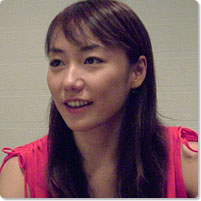
Ikuyo Kuroda
After joining the famous Tani Momoko Ballet Company at the age of six, Ikuyo Kuroda continued to study classical ballet all through her school and college years. It was a term of study in London at the Laban Centre during college that sparked her interest in contemporary dance and eventually led her into this genre. In 2000 she became a dancer with the contemporary dance company “Kim Itoh + the Glorious Future (Kagayaku Mirai)” and performed in many productions in Japan and abroad. In 2002 she made her debut as a choreographer with the work SIDE-B that subsequently won the National Committee Award of the Yokohama Platform of Rencontres Chorégraphiques Internationales de Seine-Saint-Denis (successor to the present “Bagnolet” International Choreography Award. In April of the same year she started the all female dance company BATIK. In 2003 she won the Excellence Prize at the SPAC Dance Festival 2003 organized by the Shizuoka Performing Arts Center the grand prize at the Toyota Choreography Award 2003, namely “the New Generation Choreographer Award.” In 2004 she won the 4th Asahi Performing Arts Award and the Kirin Dance Support Award for directing, choreographing and performing in her works Hana wa Nagarete, Toki wa Katamaru and SHOKU. In this way she established herself as a choreographer of renown within a very short time from her debut. Her other choreographed works include AURA and Last Pie.
Interviewer: Tatsuro Ishii
2005 BATIK European tour
1 – 2 Oct. 20:00
1 – 2 Oct. 20:00 Performance at Mousonturm Frankfurt, Frankfurt
https://www.mousonturm.de/neptun/neptun.php/oktopus/page/1/6
6 ,7, 8 Oct. 20:30
Performance at Maison de la cultura du Japon, Paris
12 – 13 Oct. 19:00
Performance at Sigyn Hall at Turku Conservatory, Turku
14. Oct. p.m.
Workshop at Sigyn Hall, Turku
http://www.turunkonservatorio.fi/
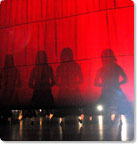
BATIK
SIDE B
Photo by Shinji Suzuki
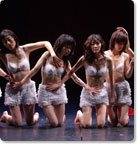
BATIK
SHOKU
Photo by Koichiro Saito
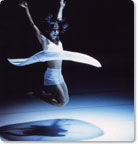
BATIK
Hana wa Nagarete, Toki wa Katamaru
(Flowers Flow, Time Coagulates)
Photo by Yoichi Tsukada
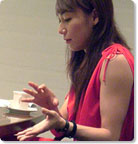
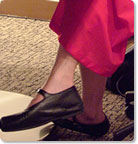
Related Tags

